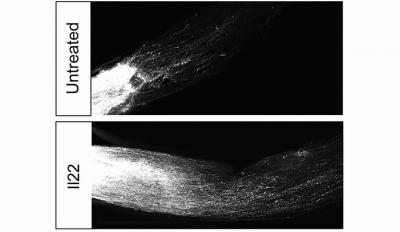
Axons extending from the eye (left) to the brain (right) in the optic nerve after the nerve has been crushed. In the control, untreated case (top) very few nerve fibers succeed in growing back. After suppression of Interlukin-22 (Il22) in the retina, many more axons can regenerate from the injury. Image credit: Strittmatter lab, Yale School of Medicine
When central nervous system cells in the brain and spine are damaged by disease or injury, they fail to regenerate, limiting the body’s ability to recover. In contrast, peripheral nerve cells that serve most other areas of the body are more able to regenerate. Scientists for decades have searched for molecular clues as to why axons — the threadlike projections which allow communication between central nervous system cells — cannot repair themselves after stroke, spinal cord damage, or traumatic brain injuries.
In a massive screen of 400 mouse genes, Yale School of Medicine researchers have identified 40 genes actively involved in suppression of axon regeneration in central nervous system cells. By editing out one of those genes, they were able to restore axons in ocular nerves of mice damaged by glaucoma.